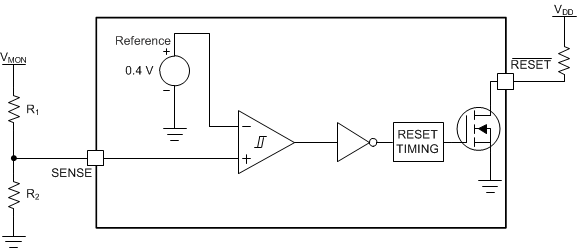SBVS301B October 2016 – September 2021 TPS3850
PRODUCTION DATA
- 1 Features
- 2 Applications
- 3 Description
- 4 Revision History
- 5 Pin Configuration and Functions
- 6 Specifications
- 7 Detailed Description
- 8 Application and Implementation
- 9 Power Supply Recommendations
- 10Layout
- 11Device and Documentation Support
- 12Mechanical, Packaging, and Orderable Information
Package Options
Mechanical Data (Package|Pins)
- DRC|10
Thermal pad, mechanical data (Package|Pins)
- DRC|10
Orderable Information
8.1.3 Adjustable SENSE Configuration
The TPS3850H01 has an undervoltage supervisor that can monitor voltage rails greater than 0.4 V. Table 8-6 contains 1% resistor values for creating a voltage divider to monitor common rails from 0.5 V to 12 V with a threshold of 4% and 10%. These resistor values can be scaled to decrease the amount of current flowing through the resistor divider, but increasing the resistor values also decreases the accuracy of the resistor divider. General practice is for the current flowing through the resistor divider to be 100 times greater than the current going into the SENSE pin. This practice ensures the highest possible accuracy. Equation 7 can be used to calculate the resistors required in the resistor divider. Figure 8-3 shows the block diagram for adjustable operation.

| INPUT VOLTAGE (V) | 4% THRESHOLD | 10% THRESHOLD | ||||
|---|---|---|---|---|---|---|
| R1 (kΩ) | R2 (kΩ) | THRESHOLD VOLTAGE (V) | R1 (kΩ) | R2 (kΩ) | THRESHOLD VOLTAGE (V) | |
| 0.5 | 16.2 | 80.6 | 0.48 | 10 | 80.6 | 0.45 |
| 0.8 | 75 | 80.6 | 0.77 | 64.9 | 80.6 | 0.72 |
| 0.9 | 93.1 | 80.6 | 0.86 | 82.5 | 80.6 | 0.81 |
| 1.2 | 150 | 80.6 | 1.14 | 137 | 80.6 | 1.08 |
| 1.8 | 267 | 80.6 | 1.73 | 249 | 80.6 | 1.64 |
| 2.5 | 402 | 80.6 | 2.40 | 374 | 80.6 | 2.26 |
| 3 | 499 | 80.6 | 2.88 | 464 | 80.6 | 2.70 |
| 3.3 | 562 | 80.6 | 3.19 | 523 | 80.6 | 2.99 |
| 5 | 887 | 80.6 | 4.80 | 825 | 80.6 | 4.49 |
| 12 | 2260 | 80.6 | 11.62 | 2100 | 80.6 | 10.82 |
 Figure 8-3 Adjustable Voltage Divider
Figure 8-3 Adjustable Voltage Divider